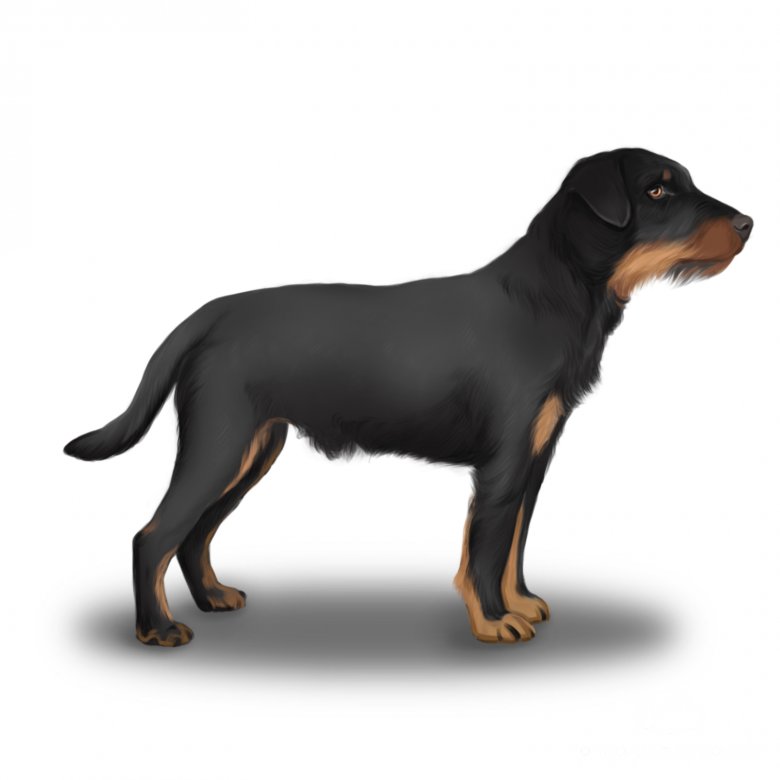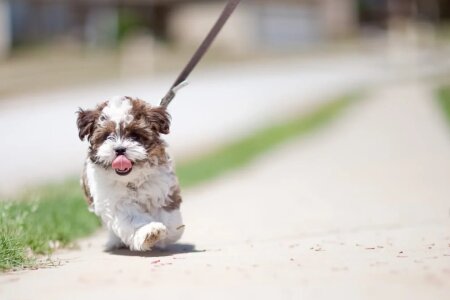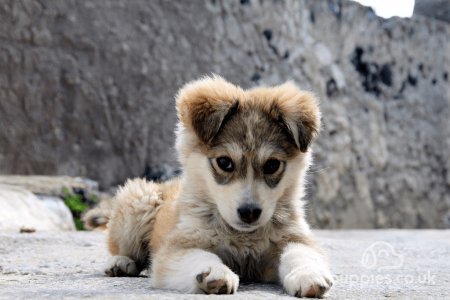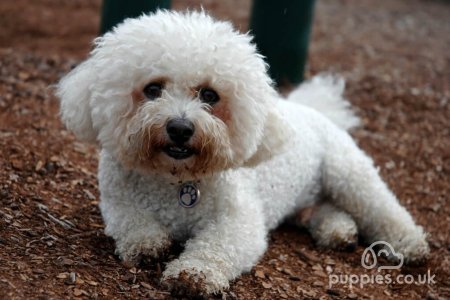Jagdterrier (Deutscher Jagdterrier, German Jagdterrier, German Hunting Terrier, German Hunt Terrier)
Overview
Although quite rare in the UK, Jagdterriers are renowned hunting dogs in their native Germany and elsewhere in Europe. Prized for their practical hunting abilities and their compassionate, obedient side, the Jagdterrier is a small breed but one with a big heart, making them loving companions for owners and their families.
Jagdterriers are smart, healthy, and relatively low-maintenance, so it should come as no surprise that they are gaining popularity outside of their native Germany.
Physical Appearance
The Jagdterrier is a small-sized breed, normally with a black and tan-coloured coat. When standing, the Jagdterrier exudes courage in a compact but well-proportioned form. His gait is lively and covers a lot of ground, with both front and hind legs remaining parallel and straight.
His resolute expression is marked by deep, dark, oval eyes. V-shaped ears sit high and drop, but not fully. His tail is well-set and slightly raised, and when not docked, is carried either horizontally or with a sabre-like curvature.
The coat is typically black and tan, but other acceptable variations include: dark brown or greyish-black, with coloured markings ranging from yellow to red on the eyebrows, chest, muzzle, legs, and at the base of the tail. White is undesirable.
The Jagdterrier somewhat resembles other terriers, at least in his build and musculature. The breed originally came from Fox-Terrier breeding lines.
How big do Jagdterrier dogs get?
Character Traits
With a confident spring in his step, the Jagdterrier exudes a hard-working, courageous, and firm temperament. Whilst the Jagdterrier is full of temperament and has some capacity for independence, he thrives on being given tasks to perform.
Jagdterriers were originally bred for hunting quarry both underground and above ground, so this is their natural element and they’re best suited for owners that are either hunters themselves or at least can provide them with plenty of activities whereby they can engage their natural instincts. For this reason, they may not be the best breed choice for first-time owners, particularly those simply looking for a house pet.
Moreover, Jagdterriers are a high energy breed and as such require plenty of exercise and rigorous training, especially as puppies.
Are Jagdterrier dogs intelligent? Yes, very.
Are Jagdterrier dogs affectionate? Yes.
Do Jagdterrier dogs have high or low energy levels? Very high energy.
Are Jagdterrier dogs loyal? Yes.
Are Jagdterrier dogs playful? Yes.
Are Jagdterrier dogs aggressive? No.
Are Jagdterrier dogs easy to train? Yes, very.
Are Jagdterrier dogs good guard dogs? No, but they make for excellent watchdogs.
Ability to Socialise
It is important that Jagdterrier owners begin training their companions from puppies into adulthood with regimen and temperance. Jagdterriers are a highly intelligent breed, which means that failure to train them and socialise them well as puppies can lead to naughty behaviour.
Their training and socialisation needs can be demanding for owners, which means that first-time pet owners may want to consider a different breed. Owners with experience at socialising puppies will be able to identify and correct bad behaviour early on so that they grow into well-behaved companions.
Around other pets, Jagdterriers can get along fairly well so long as they’re well-socialised. This includes cats and other dogs. Poor training, however, will most certainly lead to them engaging their high prey drive and to chasing.
With children, Jagdterriers are friendly and playful, although they can be demanding owing to their high energy levels. Keep your children under supervision whilst playing with Jagdterrier puppies to ensure nothing gets out of hand.
Jagdterriers can adapt fairly well to various environments and they are somewhat adaptable. Apartments without a yard are acceptable, but not ideal. Larger estates with gardens are better-suited for Jagdterriers so that they can play, roam, and work off their high energy.
Do Jagdterrier dogs get along with other pets? Not really. They will likely chase small pets and cats.
Do Jagdterrier dogs get along with other dogs? Yes, somewhat.
Are Jagdterrier dogs good with kids? Yes, very.
Are Jagdterrier dogs good with strangers? Yes.
Lifestyle Suitability
This breed is best suited to owners who are highly active and can provide plenty of outdoor exercise and playtime. They are not a very good choice for first time puppy owners and instead should be adopted or purchased by owners who have experience with training and socialisation of puppies.
Jagdterriers are fairly adaptable to different environments, including rural and urban settings, but they do have a high prey drive and will likely chase other small animals around. For this reason, keep them on a lead in public areas.
Are Jagdterrier dogs good for first-time owners? No.
Are Jagdterrier dogs hypoallergenic? No.
Are Jagdterrier dogs prone to drooling? Yes, but not too much.
Are Jagdterrier dogs a good breed for apartment living? Somewhat, but it isn’t ideal.
Do Jagdterrier dogs shed a lot? Moderately.
Do Jagdterrier dogs bark a lot? Occasionally.
Can Jagdterrier dogs be left alone at home? Yes, but only for a few hours at most.
Can Jagdterrier dogs handle the heat? Yes.
Can Jagdterrier dogs handle cold temperatures? Not too well.
Are Jagdterrier dogs sensitive to loud noises? Yes.
General Health & Health Issues
Generally, Jagdterriers have above-average health and do not suffer from as many hereditary issues as most other breeds do. In fact, there is only one health concern that prospective owners should care for, Primary Lens Luxation (PLL). Otherwise, the breed is quite healthy and routine checkups with the veterinarian can help identify and diagnose any potential problems and remedy them early on.
Some common problems include:
Primary Lens Luxation (PLL): Jagdterriers, like many other breeds, tend to suffer from PLL. This condition involves the deterioration of the tissue fibres that connect the eye, which in turn blocks fluid drainage from the eye and leads to glaucoma. Fortunately, it is possible to test for PLL and diagnose it early on with the assistance of a veterinarian;
Ear infections: most breeds, including Jagdterriers, can fairly easily accumulate earwax and develop painful ear infections. Every time you groom your Jagdterrier, have a look at his ears and clean them out.
How long do Jagdterrier dogs live? - 13-15 years
Exercise & Play Time
Jagdterriers are a playful breed and boast high energy levels. Consequently, owners should ensure that they are given plenty of outdoor exercise and are kept mentally and physically stimulated to remain happy, healthy, and tired. A tired dog is a happy dog, as the saying goes.
Originally bred for hunting, Jagdterriers thrive on activities whereby they can best use their instinct to chase and run, so even a simple stick can keep them entertained and in top shape. Just don’t overdo it, especially as puppies. Too much exercise may be detrimental to puppies.
Devote at least one hour of good exercise every day with your Jagdterrier. A brisk morning walk or jog followed by exercise time in the evening should suffice, but also allow your Jagdterrier to play outdoors if possible. Ensure that you supervise him so that he doesn’t misbehave.
Although Jagdterriers tend to enjoy playing in the water, they may get stuck in some watercourses, so always maintain supervision.
How much exercise does a Jagdterrier dog need? - About 1-2 hours per day
Do Jagdterrier dogs like water play? Yes, but always maintain supervision.
Nutrition & Feeding
Jagdterriers are lean and muscular, and to match their high energy levels they also require an adequately healthy diet of high-quality dog food. Lean proteins, vitamins, and minerals are all excellent, and a raw food diet or cold-pressed food may be beneficial over kibble. Just make sure you discuss alternative diets with your veterinarian and maintain a strict feeding schedule, especially from puppies to 12 months old.
Are Jagdterrier dogs prone to weight gain? Yes, especially as they age.
How much should I feed a Jagdterrier puppy? About 50-190g per day, in 3-4 sessions.
How much should I feed an adult Jagdterrier dog? About 100-210g per day, in total.
Care & Maintenance
When it comes to grooming, Jagdterriers are quite low-maintenance. They shed a moderate amount, but they don’t create too much of a mess thanks to their short, smooth, and hard coat that does an excellent job of naturally wicking away most water and dirt.
Their emotional care needs are fairly high, however. Jagdterriers can tolerate some isolation, but they do thrive on social interaction and constantly require affirmation and care from their owners and family members.
smooth, shorthaired, hard coat is easy to groom. Comb and brush with a firm bristle brush, and shampoo only when necessary. You can remove loose hair by wiping the coat with a warm, damp cloth. This breed is an average shedder.
- Grooming: once per week, use a comb and a firm-bristled brush to remove loose and dead hairs. Keep your home tidy by vacuuming hairs, especially in spring and autumn when shedding levels peak.
- Emotional care: do not leave your Jagdterrier alone at home for anything more than a few hours. They are an intelligent terrier breed, which means they’ll be more prone to moving from boredom to destructive behaviour like chewing or biting furniture, shoes, and upholstery if neglected.
History of the Jagdterrier
The Jagdterrier can be dated back to the interwar period in Germany, during which time cynologists Carl Eric Gruenewald and Walter Zangenbert attempted to breed Fell terriers to produce an ideal hunting dog.
During this period, a fervent growing sense of nationalism, combined with adaptations of American eugenics programmes and genetic engineering, created a fascination amongst many German cynologists for the Jagdterrier. It was believed that foreign or introduced breeds should be eliminated in favour of reintroducing mythological, extinct, or pure-bred German breeds.
Subsequent to this system of belief, the Jagdterrier was bred in highly controlled kennels whereby any defective Jagdterriers (e.g. white markings or other undesirable traits) were culled.
Although not a recognised breed by the Kennel Club, the Deutscher Jagdterrier Club (German Hunting Terrier Club) recognised the breed in 1926.
Following the war, attempts were made to introduce the Jagdterrier to America, but it was met with little acclaim. The breed was simply undesirable for its intended purpose, hunting, since it excelled at fox hunting which was not popular in the US at the time.
For this reason, the Jagdterrier remains a fairly unpopular breed outside of continental Europe and as such remains quite rare in the UK.
Interesting Facts About Jagdterrier Dogs
Initial breeding of the Jagdterrier in 1926 was very strict to ensure that only the finest, most desirable would be bred - all others were culled for even the smallest of defects.
Although bred as a hunting dog, Jagdterriers are not exactly the best hunting breed. Part of the reason is that its ancestor, the Fell terrier, is not a very good hunting breed.
Since 2007, it has been illegal to dock the tails of Jagdterriers in the UK.
Getting a Jagdterrier Puppy
There is much to consider before buying a new puppy, which is why we strongly recommend reading our buying guide. If you would like to purchase a Jagdterrier, you can rest assured that we only deal with reputable breeders.
How much does a Jagdterrier cost to buy? - About £400-£500.
How much does a Jagdterrier cost to feed? - An adult Jagdterrier costs about £0.75-£1.00 per day to feed.
How much does insurance for a Jagdterrier cost? - About £20-£45 per month.
Sensible alternatives to purchasing a new Jagdterrier puppy include rescue and adoption.
Additional resources can be found via Jagdterrier registries and associations such as:











